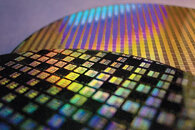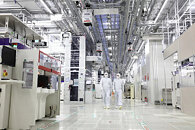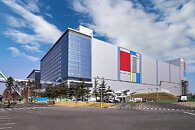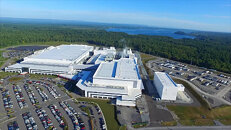T0@st
News Editor
- Joined
- Mar 7, 2023
- Messages
- 3,063 (3.88/day)
- Location
- South East, UK
| System Name | The TPU Typewriter |
|---|---|
| Processor | AMD Ryzen 5 5600 (non-X) |
| Motherboard | GIGABYTE B550M DS3H Micro ATX |
| Cooling | DeepCool AS500 |
| Memory | Kingston Fury Renegade RGB 32 GB (2 x 16 GB) DDR4-3600 CL16 |
| Video Card(s) | PowerColor Radeon RX 7800 XT 16 GB Hellhound OC |
| Storage | Samsung 980 Pro 1 TB M.2-2280 PCIe 4.0 X4 NVME SSD |
| Display(s) | Lenovo Legion Y27q-20 27" QHD IPS monitor |
| Case | GameMax Spark M-ATX (re-badged Jonsbo D30) |
| Audio Device(s) | FiiO K7 Desktop DAC/Amp + Philips Fidelio X3 headphones, or ARTTI T10 Planar IEMs |
| Power Supply | ADATA XPG CORE Reactor 650 W 80+ Gold ATX |
| Mouse | Roccat Kone Pro Air |
| Keyboard | Cooler Master MasterKeys Pro L |
| Software | Windows 10 64-bit Home Edition |
News reports from Asia point to an ongoing price battle between major chip foundries in the region—sluggish market conditions in 2023 have caused the big industry names to adjust charges, in concerted efforts to retain customers. This situation has escalated in early 2024—news media outlets claim that mainland China-situated factories have plenty of new production capacity, and are therefore eager to get their order books filled. The reports point to: "Semiconductor Manufacturing International Corporation (SMIC), Hua Hong Semiconductor and Jinghe Semiconductor lowering the price of tape-out services to chip design companies in Taiwan." Industry insiders believe that several Taiwanese IC designers have jumped onto better deals, as offered by Chinese facilities—it is alleged that Samsung, GlobalFoundries, UMC and Powerchip have all experienced a worrying increase in customer cancellations (at the tail end of 2023). The loss of long-term clients has forced manufacturers—in South Korea and Taiwan—into a price war.
TrendForce's analysis of market trends stated: "Due to the mature manufacturing processes in China, unaffected by US export restrictions, the lowered wafer fabrication costs have become attractive to Taiwanese IC design companies seeking to enhance their cost competitiveness. Reports also indicate that this competitive pressure has forced Taiwan's foundries, UMC and PSMC, to follow suit by reducing their prices. UMC has lowered its 12-inch wafer foundry services by an average of 10-15%, while its 8-inch wafer services have seen an average price reduction of 20%. These price adjustments took effect in the fourth quarter of 2023." Samsung is reportedly slashing prices by ~10-15%, and is expressing a "willingness to negotiate" with key clients in early 2024. Reports state this is a major change in attitude for the South Korean chip giant—allegedly, leadership was unwilling to budge on 2023 tape-out costs. TrendForce reckons that TSMC's response was a bit quicker: "(having) already initiated pricing concessions last year, mainly related to mask costs rather than wafer fabrication. It was reported that these concessions primarily applied to the 7 nm process and were dependent on order volumes."




View at TechPowerUp Main Site | Source
TrendForce's analysis of market trends stated: "Due to the mature manufacturing processes in China, unaffected by US export restrictions, the lowered wafer fabrication costs have become attractive to Taiwanese IC design companies seeking to enhance their cost competitiveness. Reports also indicate that this competitive pressure has forced Taiwan's foundries, UMC and PSMC, to follow suit by reducing their prices. UMC has lowered its 12-inch wafer foundry services by an average of 10-15%, while its 8-inch wafer services have seen an average price reduction of 20%. These price adjustments took effect in the fourth quarter of 2023." Samsung is reportedly slashing prices by ~10-15%, and is expressing a "willingness to negotiate" with key clients in early 2024. Reports state this is a major change in attitude for the South Korean chip giant—allegedly, leadership was unwilling to budge on 2023 tape-out costs. TrendForce reckons that TSMC's response was a bit quicker: "(having) already initiated pricing concessions last year, mainly related to mask costs rather than wafer fabrication. It was reported that these concessions primarily applied to the 7 nm process and were dependent on order volumes."




View at TechPowerUp Main Site | Source



